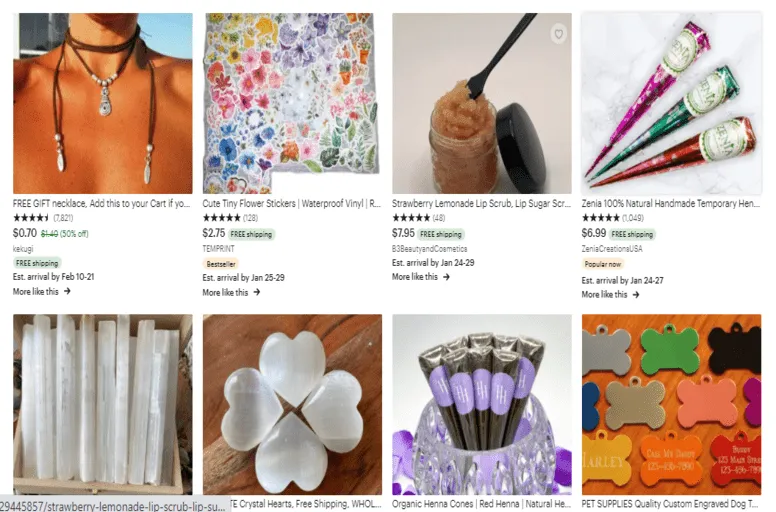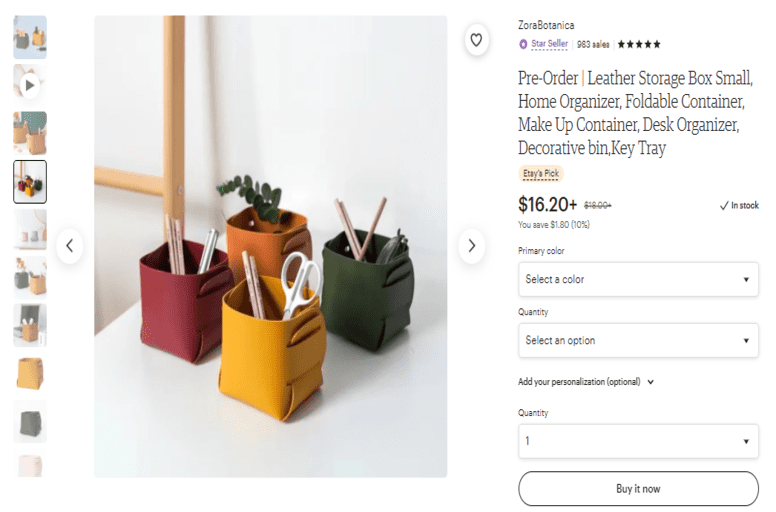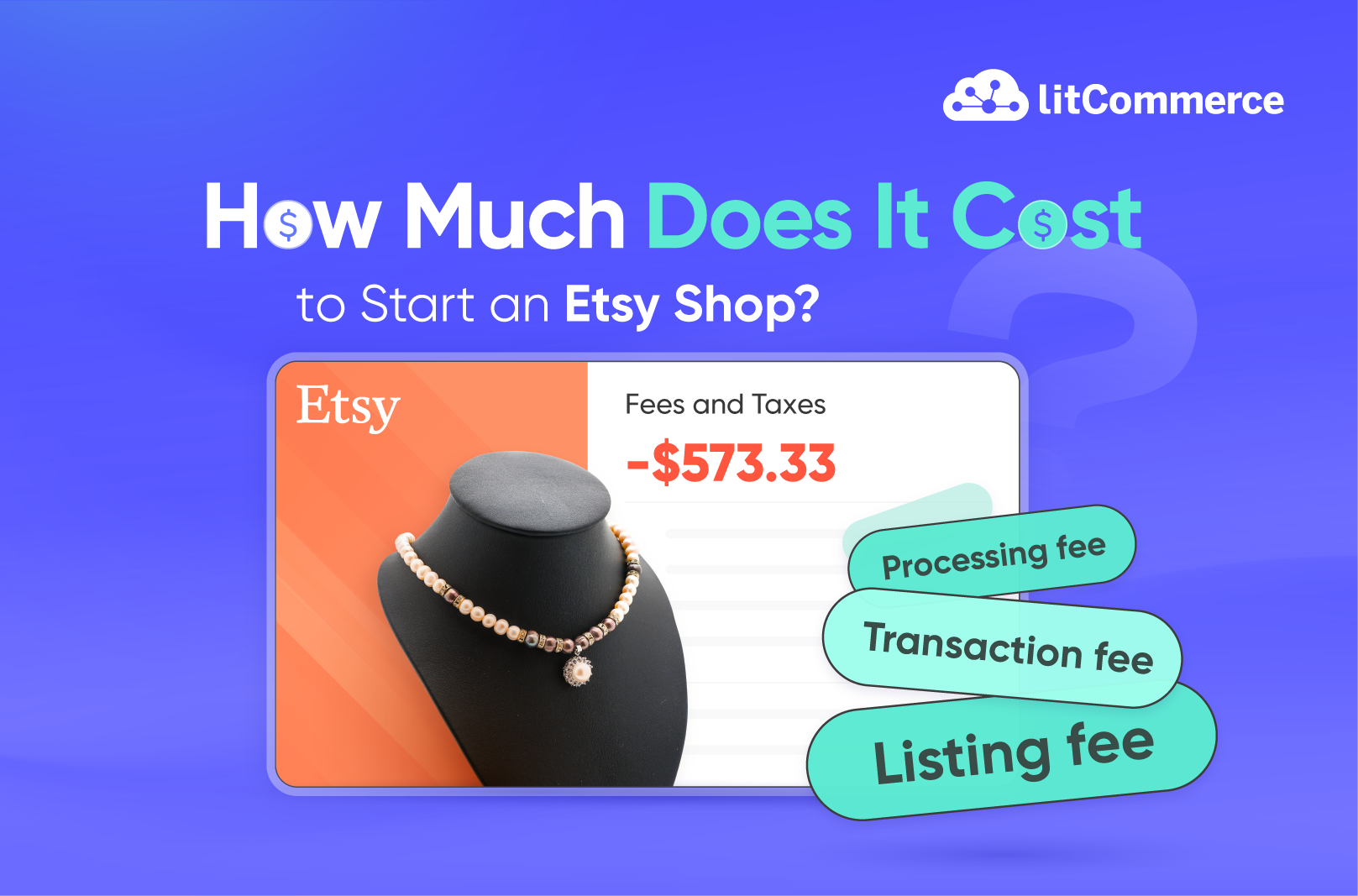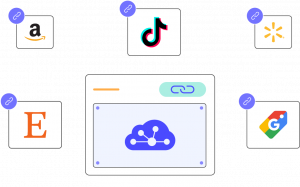How much does it cost to start an Etsy shop in 2025?
Starting an Etsy shop is budget-friendly, but there are a few small fees to keep in mind. You might pay a one-time setup fee between $15 and $29 (based on seller reports). Each listing costs $0.20, and Etsy takes a 6.5% transaction fee per sale. There’s also a 3% + $0.25 payment processing fee for each order. While the upfront costs are low, it’s good to plan for these fees as your shop grows.
In this guide, you’ll understand everything about Esy seller fees as follows:
- A clear breakdown of Etsy seller fees
- An example based on a $15 handmade product
- How to pay Etsy fees: Clear guidance
- Tips to reduce Etsy fees smartly
Keep scrolling and start breaking down these fees together so that you have a complete outlook on Etsy selling fees now!
Grow Your Etsy Multichannel Business with LitCommerce
To boost your online profit, going multichannel selling is more crucial than ever. Try out LitCommerce’s solution to integrate your Etsy store with other top online marketplaces effectively and affordably now!
Etsy Seller Fees for Beginners – How Much Does it Cost to Start an Etsy Shop?
When you learn to start selling on Etsy, you might wonder about the fees that you need to pay to sell on this biggest marketplace.
Overall, you can start an Etsy shop for free and receive 40 free Etsy listings; however, the marketplace will charge certain fees, which will be discussed below.
1. Etsy shop set-up fee: $15 one-time
When opening a new Etsy shop, you may see a setup fee of $15. This one-time, nonrefundable charge helps cover Etsy’s administrative and fraud-prevention costs. Some sellers—depending on their location or verification needs—might see a higher fee, up to $29.
Not everyone is charged. Etsy applies the fee based on factors like your country or account setup. You’ll see it listed as “Setup Fee” in your payment account during registration or shortly after.
While small, it can impact new sellers on tight budgets. It’s smart to budget around $29, just in case. Combine this with other startup fees, such as listings, and plan your launch to maximize the return on your investment.
2. Etsy listing fee: $0.20/product
Regarding how much does it cost to list on Etsy, each time you add a new set of products or create a new listing, Etsy will charge you $0.20 as a listing fee. Listings stay active for 4 months or until sold. Renewals cost another $0.20.
There are 2 kinds of Etsy pricing for listing:
- Auto-renewal sold fees
If you list multiple items and only some sell, Etsy auto-renews the listing and charges $0.20 to keep the rest active.
- Multi-quantity listing fee
When selling multiple items from one listing, you pay $0.20 per additional item sold. For example, selling 10 units costs $2.00 in total listing fees.
You can learn more about multi-quantity listing fees in Etsy help center.
So, how do the fees appear?
In your payment account, fees show as:
- Listing: initial post
- Multi-quantity fee: extra items sold
- Auto-renew sold: partial sale with leftover stock
Is Etsy Free? Etsy is free to join, but selling comes with costs. The Etsy store cost starts with listing fees, making it essential to plan your budget.
Note:
3. Subscription fee: $10/month (optional)
Is there a monthly fee for Etsy? Another Etsy store cost is the monthly fee you may pay for the marketplace. You can choose between two packages:
- Etsy Standard: This is the default plan, which is free for everyone.
- Etsy Plus: $10/month if you want extra tools.
Etsy Plus gives sellers:
- Monthly listing and ad credits
- Custom shop banner options
- Restock request tools
- Discounts on custom domains
It’s helpful for those ready to grow or brand their shop more professionally.
However, please note that your Etsy monthly fee will be charged on the same day every month. This feature is called Auto-renew on Etsy.
For example, if you are selling on Etsy USA and you sign up on March 3rd, you will need to pay a subscription fee automatically on April 3rd, May 3rd, and so on.
For newbies who are finding out how much does it cost to start an Etsy shop, the standard tier will be the best option. By choosing this free plan, new sellers can save more money and explore the marketplace before investing more.
4. Etsy transaction fee: 6.5% of sale price
Another fee that you will see a lot when getting Etsy daily bills – Etsy transaction fee. This fee is charged whenever you make a transaction.
Transaction fee basics:
- Etsy takes 6.5% of the total cost for each product which applies to the item price, shipping cost, and gift wrap (if offered).
- The fee amount is posted automatically to your payment account.
Note: The transaction fee will not apply to sales tax if you sell from the US. On the other hand, if you sell from anywhere other than the US, the transaction fee will apply to the listing price (which should include any applicable taxes that you, as a seller, are responsible for), shipping price, and gift wrapping fee.
5. Etsy payment processing fee: 3% + $0.25 (U.S.)
When planning how much does it cost to start an Etsy shop, don’t overlook Etsy store fees like the payment processing fee.
This fee is applied to every order made through Etsy Payments and is charged in addition to the 6.5% transaction fee.
How does this payment processing work?
The processing fee includes a set percentage + flat rate per order, based on your bank’s country. It applies to the item price, shipping, and sales tax (if applicable), and is deducted automatically.
Payment processing fees vary depending on your country. Let’s look at the sample fees by country:
- United States: 3% + $0.25
- United Kingdom: 4% + £0.20
- Vietnam: 4.5% + 11,500 VND
- India: 5% + ₹25
- Türkiye: 6.5% + 14 TRY
For accurate details, check Etsy’s official fee table based on your location.
To be more clear, between the 6.5% transaction fee and your local payment processing fee, how much does Etsy take per order? Typically, 8–10% or more of the total sale—depending on your region. It’s essential to include these in your full Etsy store fees calculation.
What happens with refunds? If you issue a refund, Etsy will return part of the payment processing fee in proportion to the refunded amount.
6. Currency conversion fee: 2.5% (if applicable)
If your shop’s listing currency is different from your payment account currency, Etsy charges a 2.5% currency conversion fee on each sale.
This fee is automatically subtracted from your earnings before they appear in your payment account.
Etsy converts the sales amount from your shop currency to your payout currency using the current market rate. You can check the applied rate by downloading your Etsy Payments Sales CSV file.
For sellers in Bulgaria, Croatia, Czech Republic, Hungary, Poland, and Romania, Etsy pays out in Euros. Your local bank may charge a foreign exchange fee when converting these funds to your local currency.
However, this fee only applies when there’s a mismatch in currencies, so if your listing and payout currencies are the same, you’re not affected.
To better understand how much does it cost to start an Etsy shop, you should use an Etsy fee calculator tool for determining the total cost you might have to pay for currency conversion.
7. Offsite ads fee: 12%-15% (if sale from ads)
Etsy offers multiple services to help you advertise your listings and promote your shop, including Etsy Ads and Offsite Ads.
Etsy promotes listings on external sites—like Google, Facebook, and partner blogs—through Offsite Ads. You only pay a fee if a buyer clicks your ad and makes a purchase within 30 days. Even repeat purchases during that window are eligible for the fee. If the buyer’s last click is from an Etsy Ad instead, only the Etsy Ads fee applies.
How much is the offsite ads fee? The percentage depends on your shop’s annual revenue:
- Less than $10,000/year: 15% fee
- $10,000 or more/year: discounted 12% fee
- Fee cap: Never exceeds $100 per order
Who is required to use offsite ads?
By advertising on Etsy you can increase your chance to attract more customers on this marketplace and generate more sales.
8. Shipping label fees: from $0.93 (optional)
Regarding how much Etsy takes for the shipping service, these fees will not be fixed but depend on many factors. Overall, when running an Etsy store, sellers might pay an amount for shipping, including:
- Shipping labels: The cost of the shipping label will depend on the shipping carrier, and the origin, destination, weight, and dimensions of the package.
- Signature confirmation or insurance: If you add signature confirmation or insurance, those fees will be added to the total cost of the label at the point of purchase.
You must accept Etsy Payments or PayPal as payment methods to purchase shipping labels through Etsy. Shipping fees and any adjustments are reflected in your payment account and deducted from your current balance.
9. Pattern fees: $15/month (optional)
Pattern is Etsy’s optional tool to build a custom standalone website that syncs with your Etsy shop. It’s free to try for 30 days. After the trial, you’ll be charged $15/month, plus tax where applicable.
What’s included?
- No additional listing or transaction fees for Pattern-only items
- Payment processing fees still apply
- Monthly fee is non-refundable and auto-renews until canceled
- Fee is converted to your payment account currency
Optional domain fees
- Custom domain (via Tucows): price varies
- WHOIS privacy protection: $3/year (optional but recommended)
If you cancel Pattern, your domain stays active, and you can point it to another website. Pattern is ideal for sellers who want a more branded storefront alongside their Etsy shop—without separate product management.
The pattern does not charge sellers if they only list on Pattern. However, if you want to list on both the Etsy marketplace and Pattern, you will need to pay $0.20 initially for the listing fee, which may change based on your chosen services.
10. In-person selling fees: No extra Etsy fee (if using Square)
Etsy lets you sell in person using Square, its official point-of-sale partner. While there’s no separate Etsy fee for in-person selling, certain charges still apply depending on how your sale is processed.
1. Synced listings with Square
If your in-person sale uses inventory synced from your Etsy shop:
- No extra Etsy transaction fee
- A $0.20 auto-renewal listing fee applies—just like online sales
- Square’s own processing fees apply (based on your account and sale type)
2. Manual Square sales (not synced)
If the item sold via Square is not synced with an Etsy listing:
- Etsy charges a $0.20 fee per transaction
- This appears on your bill as a “Square manual” fee
Square will still charge standard processing fees, which vary by region and payment method.
11. Etsy taxes
Final part of our breakdown on “How much does it cost to start an Etsy shop” – Etsy taxes.
Etsy may charge VAT or local tax equivalents (like GST or QST) on seller fees, depending on your location and business status. This applies to sellers in the EU, UK, Australia, India, Vietnam, Türkiye, and other eligible countries.
If you’ve added a valid VAT ID to your account, Etsy won’t charge VAT, but you’ll still get a monthly invoice confirming no VAT was collected. If you haven’t added a VAT ID and Etsy is required to collect VAT in your region, the tax will be included in your seller fees.
For some countries—like Ireland, Vietnam, Japan, and South Africa—VAT is charged even if a VAT ID is submitted.
Etsy issues monthly VAT invoices on the 1st of each month, covering the previous month’s charges. You can download them in your Payment account. If a fee is refunded, Etsy will include a VAT credit note in that month’s invoice.
To ensure accuracy, Etsy recommends contacting your local tax authority for region-specific guidance.
How to Calculate My Etsy Seller Fees?
1. The formula to calculate the seller fees on Etsy
To calculate your Etsy cost to sell, use the following formula:
Etsy Fees = Listing Fees + Transaction Fees + Payment Processing Fees + Shipping Fees + Optional Fees ( Etsy Ads Fees, In-Person Selling Fees, or Pattern Fees)
Remember that Etsy’s fees can change over time, so always double-check the fees on the official Etsy website to ensure that you are up-to-date on the latest information.
2. Example of the cost for selling on Etsy
Let’s say you just opened an Etsy shop to sell your handmade teacups. Each cup is listed at $15 USD. Here’s a simple breakdown of what fees you’ll pay and what you’ll actually earn per sale.
1. Upfront cost to get started
- Shop set-up fee: $15 (one-time)
- Listing fee: $0.20 per product listed
If you list just one product, your total upfront cost is $15.20.
2. Ongoing fees per sale
Once a teacup sells for $15, here’s what Etsy takes:
- Transaction fee (6.5%): $0.98
- Payment processing fee (U.S.): $0.70
- 3% of $15 = $0.45
- $0.25 flat fee
- 3% of $15 = $0.45
- Listing renewal (if auto-renew is enabled): $0.20
So in total, Etsy charges $1.88 in core fees per sale (excluding optional extras).
3. What you actually earn
- Sale price: $15.00
- Minus Etsy fees: $1.88
- Net earnings: $13.12
4. Optional fees you might encounter
These only apply in specific situations:
- Shipping label fee: Starts at $0.93 (optional if purchased through Etsy)
- Offsite Ads fee:
- 15% ($2.25) if your shop made under $10,000 last year
- 12% ($1.80) if your shop made over $10,000
- Currency conversion fee: 2.5% ($0.38), if your shop and bank use different currencies
- VAT on seller fees: Varies by country and tax status
Selling on Etsy is affordable to start—just $15.20 to open and list your first product. After that, expect to pay around $1.88 per $15 sale, with optional fees depending on how you run your shop.
Want to start selling jewelry on Etsy but not sure about the costs? Check out A Complete Guide to Selling Jewelry on Etsy to get all the details you need!
How to Pay My Etsy Fees?
Now that you understand the fees associated with starting an Etsy shop, you may be wondering how to pay these fees. It is worth noticing that If a seller fails to pay their Etsy fees, their account may be suspended or terminated. Additionally, Etsy may take legal action to recover any outstanding fees.
Therefore, as an Etsy seller, you should keep track of your fees and pay them on time to avoid negative consequences. Here are some steps for you to pay the fees:
- From Dashboard, choose Finance then go to the Payment account on your Etsy Shop manager.
- Select Pay now under Amount due.
- Select the amount you’d like to pay and choose the payment method.
- Select Submit Payment.
If above fees make you questioning “Is selling on Etsy worth it?” let’s move to the next part to see how you can reduce them.
What are The Strategies to Reduce Etsy Seller Fees?
You’ve just gone through how much does it cost to start an Etsy shop. Although there are many fees, you can implement some strategies to reduce them and maximize your profits, such as:
- Apply flat-rate shipping
- Offer free shipping
- Bundle your products
- Offer private listings
- Create variations
1. Apply flat rate shipping on your shop
Flat rate shipping is a method to standardize shipping prices and eliminate the vast ranges due to possible factors like weight, shipment distance, and seasonal spikes. Thus, flat-rate delivery is an excellent option for Etsy sellers who want to streamline their delivery processes and attract customers.
When opening an Etsy shop, you can follow these steps to apply a flat-rate:
- Determine your flat rate: Decide on a flat rate that you will charge for shipping all of your items. This rate should be based on the average cost of shipping your items.
- Create shipping profiles: Go to the Shipping settings section and create a new shipping profile. Select Flat rate as your shipping type and enter the flat rate you have decided on.
- Apply shipping profiles to your listings: Edit each of your listings and apply the appropriate shipping profile. Make sure to select the flat rate shipping profile you just created.
2. Offer free shipping for your customer

Other tactics to reduce Etsy cost to sell and generate more sales is offer free shipping. It’s because everyone loves free shipping and Etsy prioritizes shops that offer free and discounted shipping cause it brings benefits to Etsy’s customers.
It seems effortless to offer free shipping to buyers. However, if you fail to manage, you will not be able to earn more sales and effectively attract buyers. There are two approaches that you should take a look at.
Initially, you’re going to be the one who pays for the shipping. It’s a small investment but brings quite a large benefit to your customer service and attracts them more. Hence, you should implement this for a short time at the beginning of your campaign. After that, offer free shipping only on orders over a certain amount, such as $50 or $100. This can encourage customers to purchase more items from your shop to receive free shipping, which can help increase your sales and profits.
Another way to offer free shipping on Etsy without decreasing your profit is adding the shipping cost into the item’s price. For example, if you normally sell an item for $20 and shipping costs $5, you could increase the price of the item to $25 and offer free shipping. The customer will still pay $25 in total.
3. Bundle your items when listing on Etsy

When it comes to how much it costs to start an Etsy shop, the listing fee is the amount that takes a large portion of the total cost. However, you can reduce this by bundling items.
If you have items that sell in multiple quantities, such as party cups, colorful boxes, clothes… Instead of listing them individually, try to group them together and list them as a bundle product. This way, you only need to pay the listing fee (20 cents) for one bundle product while selling the same quantity as an individual listing. It’s super easy to do and helps to cut off the listing expense.
4. Offer private listings when it is possible
One more tip to save money with the Etsy listing fee is offering your customers a private listing. For the private listing, Etsy only charges $0.20 only if the item sells. If it doesn’t sell, you don’t get charged. Hence, when customers contact you to place orders, consider using the private listing for them. This way, you could save a $0.20 listing fee per item.
5. Create variations
If you have a product that can be customized in different colors, sizes, or styles, you can save money on listing fees by creating product variations instead of separate listings for each option. Etsy charges a fee of 5 cents for each additional variation, which is much cheaper than creating a new listing for each option.
By following these strategies, you can reduce your costs and maximize your profits when selling on Etsy. Further than understanding the cost to sell on Etsy, you can also leverage many Etsy tips to build a 6-figure business.
How Much Does it Cost to Start an Etsy Shop – FAQs
To know how much to sell on Etsy, you can use the following formula: Etsy Fees = Listing Fees + Transaction Fees + Payment Processing Fees + Shipping Fees + Optional Fees (Etsy Ads Fees, In-Person Selling Fees, or Pattern Fees) Here is a breakdown of each fee: It’s important to note that Etsy’s fees can change over time, so it’s always a good idea to double-check the fees on the official Etsy website to ensure that you have the most up-to-date information. There is no monthly fee to have an Etsy shop, but you can choose to pay a $10 monthly subscription for Etsy Plus. This Etsy Plus offers credits for listing and advertising, custom web address discounts, restock requests, advanced shop customization, and more. When you make a sale through Etsy.com, you will be charged a transaction fee of 6.5% of the price you display for each listing plus the amount. This fee covers the cost of using Etsy’s platform to sell your products and is automatically deducted from the payment you receive from the buyer. Etsy takes a transaction fee of 6.5% of the price you display for each listing plus the amount. This fee covers the cost of using Etsy’s platform to sell your products and is automatically deducted from the payment you receive from the buyer.
Final Words
That’s everything you need to know to answer “How much does it cost to start an Etsy shop?”.
In summary, Etsy pricing is quite competitive, and it’s quite cheap to maintain a store. The only thing that is not so affordable is shipping transaction fees. High shipping costs can be a big turn-off for customers.
Going multichannel is also a really great way to increase your revenue. You can sell not only on Etsy but also in other marketplaces such as Amazon, eBay, or Facebook. Multichannel selling will be a wonderful way to reach more customers and level up your business.
In case you need a multichannel selling tool to manage different best selling platforms more effectively, take a look at LitCommerce – we provide a solution to simplify daily management tasks, and you can control your store in just one place.
Leave us a message if you need more info.
Good luck!




